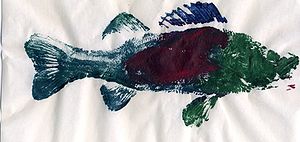
Gyotaku
Encyclopedia

There are two methods used in gyotaku. The direct approach is the best way to do gyotaku. In order to make a gyotaku print, one places the subject (e.g. fish
Fish
Fish are a paraphyletic group of organisms that consist of all gill-bearing aquatic vertebrate animals that lack limbs with digits. Included in this definition are the living hagfish, lampreys, and cartilaginous and bony fish, as well as various extinct related groups...
, crab
Crab
True crabs are decapod crustaceans of the infraorder Brachyura, which typically have a very short projecting "tail" , or where the reduced abdomen is entirely hidden under the thorax...
, scallop
Scallop
A scallop is a marine bivalve mollusk of the family Pectinidae. Scallops are a cosmopolitan family, found in all of the world's oceans. Many scallops are highly prized as a food source...
shell) on a wooden bench and paints one side with sumi ink. Then they lay a piece of material, eg. Paper, over the ink covered fish, then rub the material until there is the image of the fish on it.
Modern gyotaku artists often substitute acrylic or other painting material for the traditional sumi-e.
Gyotaku is also practiced as a form of art, and is very popular among young children both in Japan and Western countries. Sometimes, rubber fish replicas are used.
An excellent "how-to" article by Joe Higgins, "Fish Print's: Get into Gyotaku for a one-of-a-kind trophy" with detailed instructions and photos was published in the January 2010 edition of On The Water magazine.
Gyotaku sources and reference material also available at: www.natureprintingsociety.info

